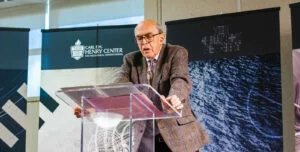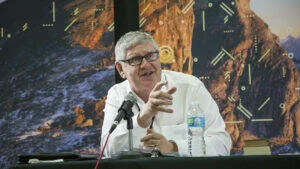Through diverse life experiences—from his background professionally as an engineer to his missionary service with ReachGlobal—Todd Patterson (PhD, Trinity International University) has become an adept bridge-builder.
In these contexts he has had opportunity to connect his Christian faith to science and technology; to share his evangelical convictions in a secular Slovak society; and to invite those “We need to begin with the realization that if God is the author of Scripture and creation, then both Scripture and science must be true and must agree”with alternative perspectives into engaging discourse. Open inquiry is largely what drew Patterson to the Creation Project: rather than merely seeking to defend orthodoxy, it “seeks to set evangelicals on a path of dialog and discovery,” which mirrors his own efforts as a scholar.
From the beginning of his academic training and into his vocation as a researcher and teacher at the Department of Theology and Christian Education (an evangelical seminary in Banská Bystrica, Slovakia), Patterson has been concerned to attune the Biblical text with the natural sciences without denying or disregarding the Bible’s authority and inerrancy. For Patterson, to think that the accounts recorded in Genesis 1–2 are irreconcilable with science is nonsensical. “We need to begin with the realization that if God is the author of Scripture and creation, then both Scripture and science must be true and must agree,” says Patterson. “[We can maintain] confidence in the perfect reliability of Scripture, knowing that when rightly interpreted it will be in perfect harmony with science that rightly reflects God’s creation order.”
Imitating our Ancestors: The Beginning of a Project
Right interpretation, then, is at the heart of Patterson’s project, Mimesis in the Biblical Historical Narrative of Genesis 1–2: Relating the Biblical Doctrine of Creation to the Modern Scientific Context. Naturally there is potential for human error in the process of interpretation—from deciphering body language, to translating poetry, to describing scientific data, or in reading an ancient text. So how then can we interpret in a way that understands rightly and with full confidence the Creation account? Patterson believes that given a different method of elucidation, the scriptures can be known rightly—and heartily affirmed as true—while bridging the seeming chasm between the doctrine of Creation and modern scientific findings.
The overarching issue Patterson proposes to address is why literary interpretations—which find poetic features in the text that allow for a non-literal understanding of the creation account—have been rejected by many evangelicals, despite being supported by ancient Near East research, text linguistics, and indeed, many evangelical Old Testament scholars. Even while his project will focus on the literary nature of scripture and the insights that may be gained through literary interpretation, Patterson affirms that evangelicals are not wrong in their reluctance to give up what has always been accepted—that is, the “plain-language interpretation” of the creation account—simply in order to appease scientific opinion.
Genesis as Literature and Historical Narrative
During his dissertation research as an Old Testament program scholar in the Theological Studies program at Trinity International University, Patterson focused extensively on the relationship between Genesis as literature and Genesis as historical narrative. “As I read Plato and Aristotle and their interpretations of mimesis for historical narrative, I discovered that evangelicals can benefit immensely from a better understanding of how biblical historical narrative faithfully depicts reality while communicating through literary convention.”
Mimesis is the representation or imitation of reality in art. Patterson notes that a challenge of mimesis is that “whenever we transfer reality [from the domain of space and time] to [the domains of painting, music, or narrative] we have to give up some part of reality in order to preserve the aspect of truth we are interested in communicating.” In narrative, for instance, this can mean that some “I discovered that evangelicals can benefit immensely from a better understanding of how biblical historical narrative faithfully depicts reality while communicating through literary convention”aspects of reality may be refashioned in order to more truthfully and accessibly convey other aspects of reality to the reader. In this way, an author does not use distortion as a means of altering truth; it is rather used purposefully to account for or accommodate the transfer of reality to representation in narrative form.
By understanding the concept of mimesis, Patterson believes, readers of the Creation account gain a new insight and ability to sort through how a text depicts—and separates from—reality: “Just by being alerted to this potential for distortion we will read more thoughtfully with a greater ability to distinguish between truth claims and mimetic accommodation.”
Examining the mimetic nature of the biblical text in order to draw a distinction between the genres of ancient historical narrative and modern or scientific historical narrative is the first proposed phase in Patterson’s project. He then plans to expand on his paper given at the 2015 Evangelical Theological Society conference, “The Man-Woman Shaped Hole in the Heart of Creation: A Mythos-Logical Reading of Genesis 2” in order to articulate a specific theological interpretation of the creation account that builds on genre sensitivity and ANE context.
Even after laying these foundations, much research remains in understanding how the literary nature of Genesis relates to contemporary scientific data regarding cosmic and human origins. It is with humility that Patterson says “This [third] phase will require a wisdom approach,” that is, beginning with the fear of YHWH as the source of wisdom; and with an openness to scientific inquiry as a “legitimate pursuit of wisdom because we are created with the ability (and task) to observe and discover the world around us and thus learn to uphold its order.”
Patterson’s desire as a Creation Project Fellow is to collaborate with philosophers and scientists, and he believes that the theory of mimesis may provide some important tools for fostering collaborative understanding between biblical teaching and scientific research.
Carl F. H. Henry Resident Fellows (2016-2017)
C. John Collins, “Genesis 1–11: Poetry, History, Science, Truth”
John Hilber, “Relevance Theory and Divine Accommodation”
Hans Madueme, “The Evolution of Sin? Sin, Theistic Evolution, and the Biological Question—A Theological Account”
Clinton Ohlers, “Evangelicals and Genesis, Before and After Darwin”
Todd Patterson, “Mimesis in the Biblical Historical Narrative of Gen 1-2”








Comments
Be the first one to make a comment!